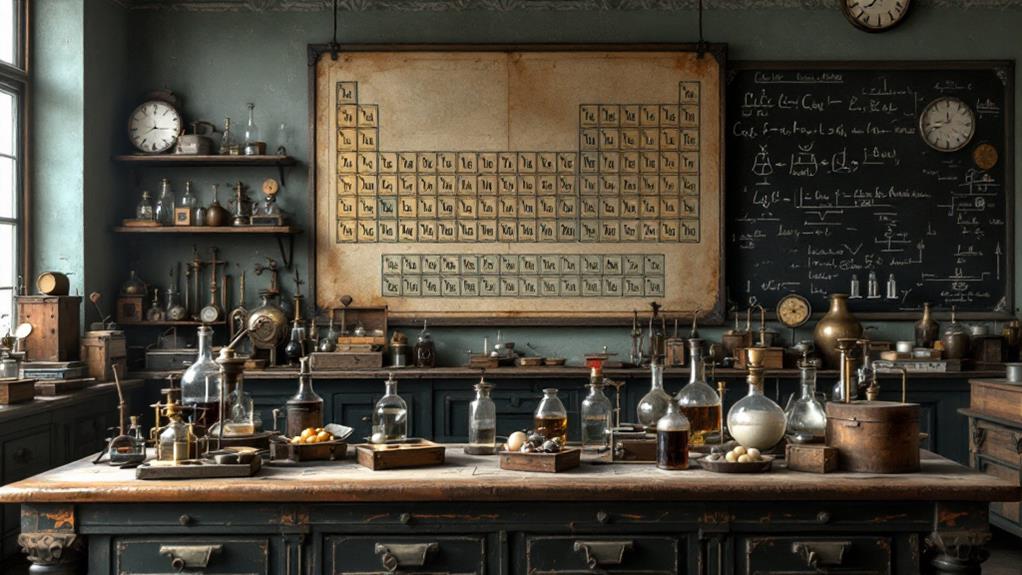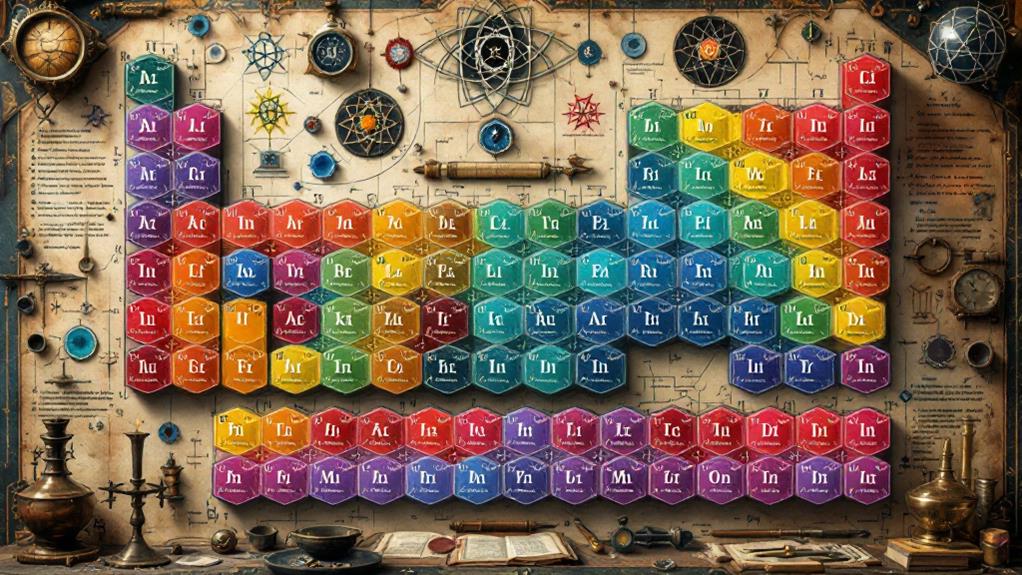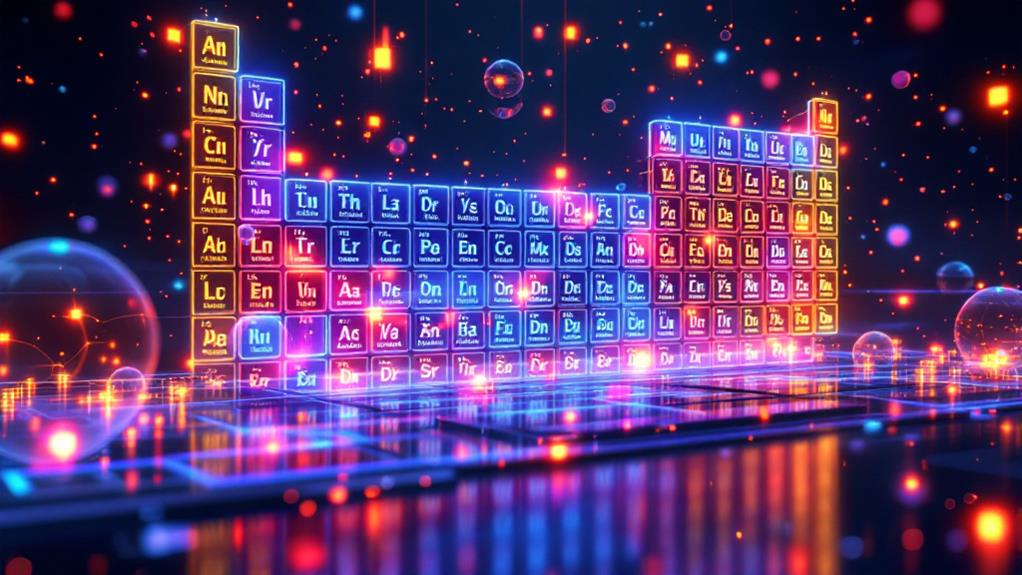The History of the Periodic Table: How Elements Were Organized

You might wonder how the periodic table came to be. In the beginning, elements were grouped by basic traits like color or reactivity. Alchemists noticed unique properties but lacked a system. Then, Dmitri Mendeleev transformed things by arranging elements with similar properties in a recurring pattern, predicting undiscovered ones. As atomic theory advanced, elements were organized by atomic number rather than weight. Modern tables showcase group trends and electron configurations. New findings and technology refine the table further. To reveal the intriguing expedition of the periodic table's evolution, there's a fascinating story waiting to unfold.
Early Element Classification
In the early days of chemistry, scientists grappled with the challenge of classifying elements. You'd find that the roots of this endeavor stretched back to ancient alchemy, where alchemists, driven by the quest for transmutation and the philosopher's stone, began recognizing distinct elemental properties. They knew that different substances behaved distinctly, yet lacked a systematic way to organize these observations.
In early chemistry, attempts at classification systems were rudimentary at best. You might imagine chemists of the time sorting elements based on perceptible traits like color, reactivity, and phase. However, without a deeper understanding of atomic structure and behavior, these systems often fell short. For example, some might group metals together due to their shared luster and conductivity, but this was more intuitive than scientific.
You'd see that as more elements were uncovered, the need for a coherent classification system became urgent. Chemists focused on cataloging known elements by their properties, trying to find patterns that hinted at a natural order. Though these early efforts were fragmented, they laid the groundwork for more advanced methodologies that would eventually lead to the systematic arrangement of elements you recognize today.
Mendeleev's Breakthrough
As the search for a coherent classification system intensified, Dmitri Mendeleev made a groundbreaking leap in organizing the elements. His approach wasn't just about arranging elements by atomic mass; it was about recognizing patterns and relationships among them. Mendeleev's vision was revolutionary because he understood that elements with similar properties appeared at regular intervals, a concept now known as periodicity. He created a table where elements were placed into groups based on these recurring characteristics.
What truly set Mendeleev apart was his boldness in leaving gaps in his table. He didn't just ignore these spaces; instead, he made element predictions, suggesting that unrecognized elements would eventually fill these voids. By predicting the properties of elements like gallium and germanium with remarkable accuracy, Mendeleev's table gained credibility and proved its utility.
His work was more than just a chart; it was a tool for exploration. Mendeleev's vision allowed scientists to see the periodic table not just as a collection of known elements, but as a framework guiding future investigation. His breakthrough laid the foundation for understanding elemental relationships and advanced the study of chemistry in ways that continue to influence scientific thought today.
The Modern Table Emerges

Many significant advancements have shaped the periodic table into its modern form. As you investigate this fascinating evolution, you'll see how scientists built upon Mendeleev's early framework, aligning it with emerging knowledge about atomic structure and group trends. The modern periodic table not only organizes elements by increasing atomic number but also reflects their electron configurations and chemical properties.
Here's how these advancements came to be:
- Understanding Atomic Structure: The revelation of protons, neutrons, and electrons allowed scientists to comprehend how elements differed fundamentally. By focusing on atomic number rather than atomic weight, the table gained a more accurate and meaningful organization.
- Group Trends and Periodicity: You've probably noticed the repeating patterns in the table, such as how elements in the same group share similar properties. This periodicity is a result of the table's design, which highlights these trends by arranging elements with similar valence electron configurations together.
- Noble Gases and Beyond: The inclusion of noble gases provided a complete picture of group trends, emphasizing the importance of electron configurations. The modern table's layout makes it easy for you to predict chemical behavior across periods and groups.
Discoveries and Adjustments
Several groundbreaking revelations and adjustments have continued to refine the periodic table, making it an indispensable tool in chemistry. You can see how scientific collaboration has played a vital role in these developments. As researchers worked together across the globe, they uncovered new elemental properties and adjusted the table accordingly, guaranteeing it remained accurate and useful.
One notable finding you should know about is the identification of noble gases. Initially, these elements didn't fit into the existing table. Thanks to intense scientific collaboration, chemists were able to identify their unique properties and create a new group for them, which expanded the table's functionality.
Additionally, the introduction of new synthetic elements brought further changes. You might imagine the table getting updated with each revelation, as scientists confirmed these elements' properties and assured they aligned with the periodic trends. These alterations required precise experimentation and a deep understanding of elemental properties.
When you look at the periodic table today, it's clear that it reflects the collaborative efforts of scientists who tirelessly worked to incorporate each new finding. It's a reflection of the ongoing process of revelation and adjustment, all aimed at providing a thorough understanding of the elements in our universe.
The Table's Future

The future of the periodic table is filled with potential and excitement. You can expect groundbreaking changes driven by element revelation and technological advancements. As scientists push the boundaries of what's possible, they'll likely uncover new elements, reshaping the periodic table and our understanding of periodic trends. With each new element, you'll see shifts in how elements are organized, possibly introducing new groups or expanding existing ones.
Technological advancements play a vital role in this evolution. Improved tools and methods will enable precise measurements and experiments, leading to more accurate data on elements. This will impact how you learn about them, as education evolution continues to integrate these findings. You'll see more interactive and digital learning tools that make the periodic table more accessible and engaging.
Furthermore, the periodic table's future can't ignore environmental impacts. Scientists will focus on sustainable practices in element extraction and usage. Here's what you can look forward to:
- More efficient recycling technologies to reduce waste and conserve natural resources.
- Development of eco-friendly materials using newly uncovered elements.
- Increased awareness and education on the environmental implications of chemical processes.
These changes promise a dynamic and sustainable future for the periodic table.



